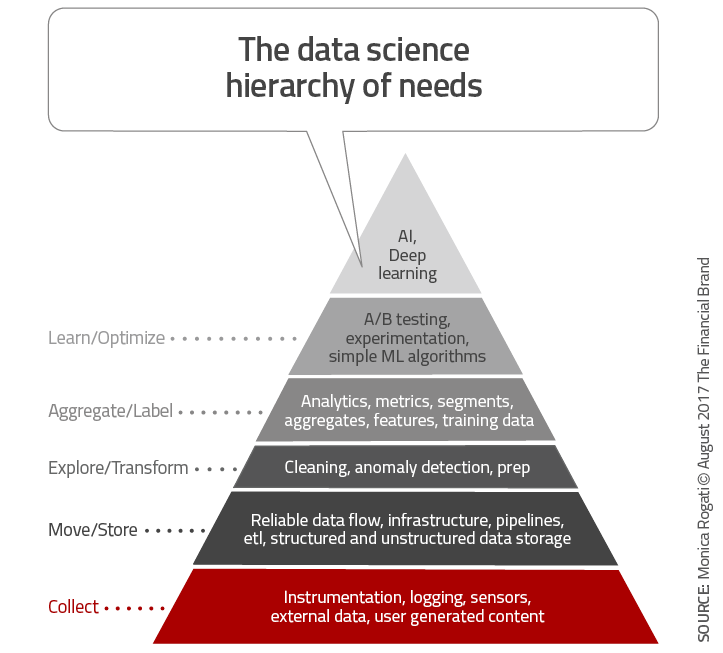With the potential of providing ‘smart’ solutions for a variety of challenges, artificial intelligence (AI) and machine learning are getting a lot of attention. But, before try to build an AI solution, make sure your data foundation is strong.
copyright by thefinancialbrand.com
 In 1943, psychologist Abraham Maslow first introduced his concept of a hierarchy of needs in his paper “ A Theory of Human Motivation .” This hierarchy suggested that people are motivated to fulfill basic needs before moving on to other, more advanced needs. Maslow’s hierarchy is most often displayed as a pyramid. The lowest levels of the pyramid made up of the most basic needs, while the most complex needs are at the top of the pyramid. Everyone is capable and has the desire to move up the hierarchy toward a level of self-actualization. Unfortunately, progress is often disrupted by failure to meet lower level needs.
In 1943, psychologist Abraham Maslow first introduced his concept of a hierarchy of needs in his paper “ A Theory of Human Motivation .” This hierarchy suggested that people are motivated to fulfill basic needs before moving on to other, more advanced needs. Maslow’s hierarchy is most often displayed as a pyramid. The lowest levels of the pyramid made up of the most basic needs, while the most complex needs are at the top of the pyramid. Everyone is capable and has the desire to move up the hierarchy toward a level of self-actualization. Unfortunately, progress is often disrupted by failure to meet lower level needs.
From basic human needs to basic data needs
Similar to Maslow’s hierarchy, data science advisor Monica Rogati has developed a similar pyramid to illustrate that while most firms are striving for the top of the data science hierarchy of needs (artificial intelligence), many more basic requirements must first be met. This is a great visual for the banking industry, where data seems abundant, but the ability to process and apply this data is less assured.
Begin With a Strong Foundation
The largest and most basic need in the data science hierarchy is the need for data collection . While every bank and credit union collects data daily on transactions, product use, customer demographics, and even external insights from social media and other sources, an organization needs to determine what specific insight may be needed to get a complete picture. Are you collecting insight on channel use, geolocational data and consumer beliefs and behaviors? While you can build a plan for future collection, the accuracy of any machine learning or AI exercise will be determined by the scope and quality of data collected. As important as the collection of the right data is important, Rogati stresses that it is equally important to have an ongoing flow of real-time data that is easy to access, store and analyze. This can be a major challenge for financial services organizations that are notorious for having data silos. Beyond internal data flows, it is important that any external or unstructured data can also be collected, stored and analyzed. While once a major problem, cloud technology has simplified some of the storage challenges. […]
read more – copyright by thefinancialbrand.com


With the potential of providing ‘smart’ solutions for a variety of challenges, artificial intelligence (AI) and machine learning are getting a lot of attention. But, before try to build an AI solution, make sure your data foundation is strong.
copyright by thefinancialbrand.com
From basic human needs to basic data needs
Similar to Maslow’s hierarchy, data science advisor Monica Rogati has developed a similar pyramid to illustrate that while most firms are striving for the top of the data science hierarchy of needs (artificial intelligence), many more basic requirements must first be met. This is a great visual for the banking industry, where data seems abundant, but the ability to process and apply this data is less assured.
Begin With a Strong Foundation
The largest and most basic need in the data science hierarchy is the need for data collection . While every bank and credit union collects data daily on transactions, product use, customer demographics, and even external insights from social media and other sources, an organization needs to determine what specific insight may be needed to get a complete picture. Are you collecting insight on channel use, geolocational data and consumer beliefs and behaviors? While you can build a plan for future collection, the accuracy of any machine learning or AI exercise will be determined by the scope and quality of data collected. As important as the collection of the right data is important, Rogati stresses that it is equally important to have an ongoing flow of real-time data that is easy to access, store and analyze. This can be a major challenge for financial services organizations that are notorious for having data silos. Beyond internal data flows, it is important that any external or unstructured data can also be collected, stored and analyzed. While once a major problem, cloud technology has simplified some of the storage challenges. […]
read more – copyright by thefinancialbrand.com
Share this: